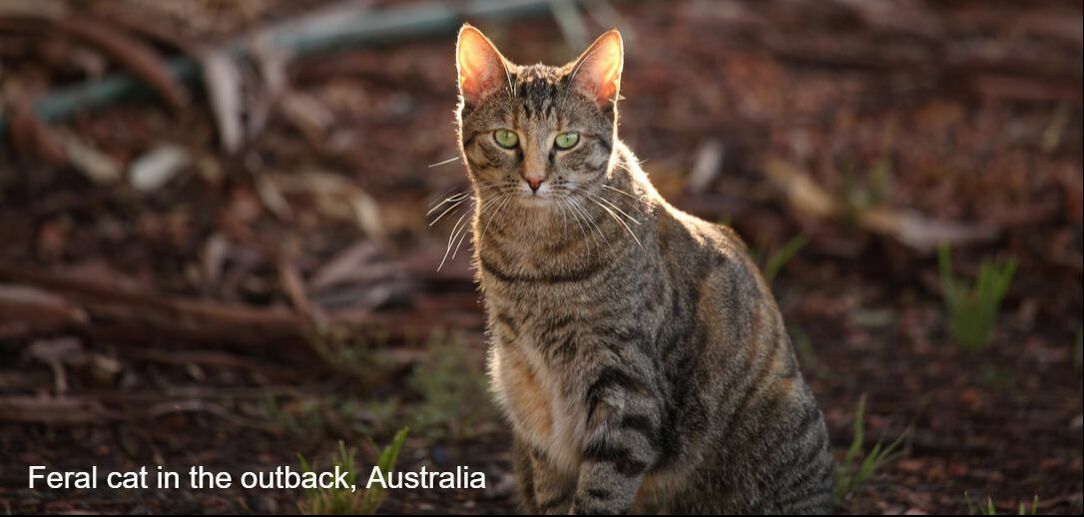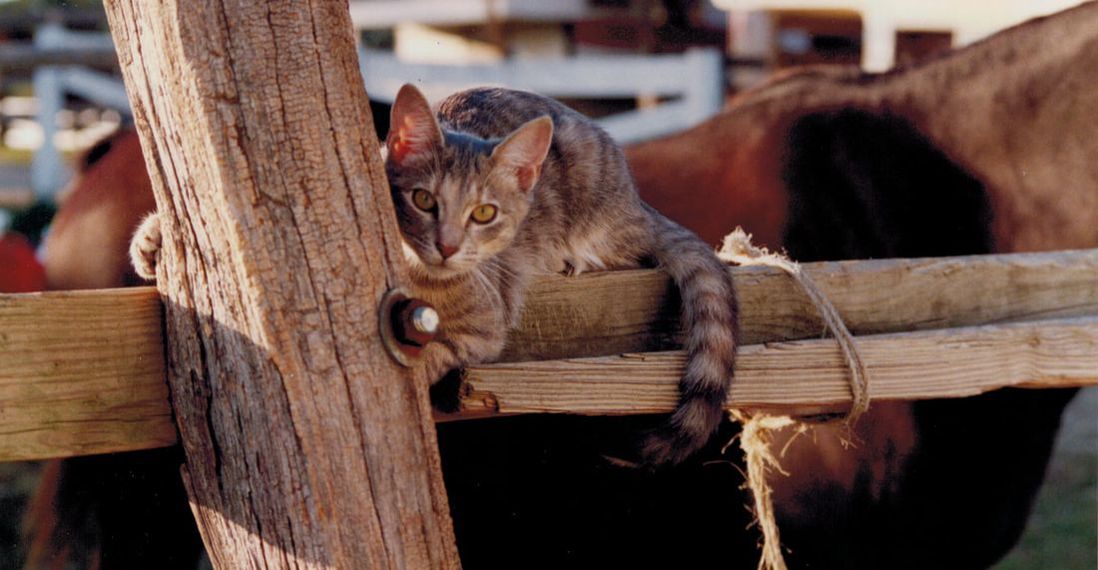|
We've got a new petition that we hope you'll sign to try and protect the feral cats of Australia. If you haven't seen the recent news story about the mass culling of cats going on right now, you can read it here. When the Australian government in 2015 announced its plan to kill 2 million cats by 2020, we were appalled just like you. We crafted a petition and wrote to the Minister for the Environment, Greg Hunt, and Ambassador to the U.S., Kim Beazley, to let them know about the humane solutions available for managing feral cats. While trap-neuter-return (TNR) by itself may not be enough to manage the outdoor cat population-especially in wild, unpopulated rural areas-that certainly doesn't mean we need to resort to the lethal methods being used in Australia today.
For example, exclusionary fencing can be used to create safe areas for both wildlife and cats; a government-supported spay/neuter program could greatly reduce the number of cats reproducing outside. We believe that when communities come together around principles like "no-kill," "adopt-don't-shop," and "compassionate conservation," they find ways to value and support each and every life, be it furry or feathered. The mass culling of animals is always a tragedy and never the answer. Unfortunately, the Australian plan was put into place and hundreds of thousands of cats, if not more, have already been killed. Please take a moment to lend your voice to feral cats in Australia and sign and share our petition.
7 Comments
Earlier today President Trump signed the Agriculture Improvement Act into law. Better known as the Farm Bill, the law contains crucial new protections for animals.
The Dog and Cat Meat Trade Prohibition Act contained within the bill bans the slaughter, trade and import/export of cats and dogs for human consumption. While consuming dogs and cats is rare in the U.S., this provision is important because only six states have laws prohibiting it. Just as critical is the trade aspect. News reports from Egypt recently suggested that the government was allowing the shipment of unowned cats and dogs abroad for consumption, to places like South Korea where the infamous annual dog meat festival takes place, as a way to reduce the population of stray animals in the country. This practice is now prohibited in the U.S. thanks to the bill. The bill also contained a measure to help animals affected by domestic violence. The Protecting Animals with Shelter (PAWS) Act provides new domestic violence protections for animals while allocating grant funds for shelters to add, improve and otherwise help find accommodations for pets in these situations. This is so important because one reason victims sometimes give for remaining in a dangerous situation is the question of what would happen to their beloved pet. Currently only 3% of shelters serving victims of domestic violence accept pets as well. Other good news for animals comes in the form of clarity around dog fighting and cockfighting, which were previously banned in all U.S. states and are now prohibited in all U.S. territories (Guam, American Samoa, the U.S. Virgin Islands and the Northern Mariana Islands) as well. Also good is something NOT in the bill. The Protect Interstate Commerce Act was thankfully rejected and removed. It would have usurped individual state and local laws passed to protect animals, such as humane farming practices and the banning of puppy mills, and made it harder for advocates and local communities to pass laws on behalf of animals. While the Farm Bill contains some great successes for animals, there is still work to be done. The KITTEN Act, which would bar the USDA from using kittens in painful experiments, has bipartisan support in the House and a version was just introduced in the Senate. You can learn more about the decades of experiments that brought about the KITTEN Act and show your support for it by signing our petition to USDA Secretary Sonny Perdue. A New Approach emerges, challenging tradition to see each tree within the forrest.by Maggie Funkhouser Whether the topic is feral cats or Bengal tigers, bald eagles or pigeons, when it comes to managing animal populations, the traditional school of conservation thinking tends to choose lethal practices as its primary tool. However, with new research and evidence showing that nonhuman animals are more similar to humans than not–studies proving these species think, feel, and possess sentience–traditional conservation is being challenged by a new ethos called “compassionate conservation,” where nonlethal practices are the focus.
Traditional conservation approaches for managing nonhuman animal populations are based on the notion that these individuals have simple minds; like machines, they only respond to stimuli, are not feeling creatures, and are “lesser” in some way. This school of thought is also hunting centric, with a firm focus on the herd or population as a whole. The idea is that if the integrity of the whole is thriving, the well-being of the individual is not necessary to consider. Evolving views With mounting evidence that nonhuman animals are capable of feeling a wide range of emotions, from joy and happiness to sadness, sorrow, and even post-traumatic stress, some scientists are beginning to shift their views of these species; and with that, they are shifting their management practices (“Animal Sentience,” 2018). This change in mindset is questioning the status quo regarding ethics and moving towards conservation that again takes into account the value of individual life with a focus on “do no harm.” “As a conservation community we have normalized the perpetration of significant, intentional, and often unnecessary harm against wildlife individuals. This constitutes a tragic failure to exercise our considerable capacities for compassion,” states Arian Wallach, an ecologist at the University of Technology Sydney in Australia, and her colleagues in a recent Conservation Biology essay. With increasing evidence surrounding the “widespread sentience and sapience of many nonhuman animals,” they state, “practices that categorically prioritize collectives without due consideration for the wellbeing of individuals are ethically untenable” (Wallach, Arian et. al., 2018). Traditional conservationists are having a hard time accepting this new approach of compassion and empathy in managing animal populations. They are holding onto the belief that in order to protect biodiversity, compassion has its limits and killing is necessary. Director of the Smithsonian Migratory Bird Center, Peter Marra, and bird advocate Chris Santella strongly support this idea. In their latest book, Cat Wars: The Devastating Consequences of a Cuddly Killer, Marra and Santella write, “From a conservation ecology perspective, the most desirable solution seems clear—remove all free-ranging cats from the landscape by any means necessary” (Marra and Santella, 2016). This new debate among scientists has placed conservation management practices on a spectrum with lethal methods at one end, occasional killing in the middle, and abstaining from lethal force at the other end of the scale. Dr. Mark Beckoff, Professor Emeritus of Ecology and Evolutionary Biology at the University of Colorado, Boulder and a pronounced leader of the compassionate conservation movement, responds to Marra and Santella’s Cat Wars, stating, “The phrase ‘by any means necessary’ is among the most reprehensible statements I’ve ever seen, and of course, in addition to it being morally repugnant, it is not based on science and it won’t work. And, think about the horrific lesson it offers to youngsters. The authors totally ignore the cognitive and emotional lives of cats, and view them as mere disposable objects” (Bekoff, 2016). Does killing work? Scientists in favor of the compassionate conservation approach point out that killing often allows root problems o be ignored. It’s easier to kill than to formulate solutions to the underlying causes; lethal practices simply provide a band-aid fix. Whereas the new school of thought looks towards ecology, natural processes, and the interconnectedness of all living things to find the answers that will most likely be more effective in providing long-term solutions over repeated killing. These scientists propose allowing nature to “take its course,” to allow natural processes within an ecosystem to self manage. For example, instead of killing apex species to manage a habitat, compassionate conservation would allow these species to naturally regulate the ecosystems in which they reside–scientists would observe more and interact less. Alley Cat Rescue strongly agrees with this school of thought and therefore advocates Trap-Neuter-Return (TNR) as the preferred method of managing feral cat populations because TNR programs–following sterilization–allow natural attrition to reduce local cat colonies. Embracing humane methods Killing has a dramatic effect on the environment, often with counterproductive results, TNR provides a practical solution with a more subtle approach to interacting with the environment. TNR stops the breeding cycle without wholly removing animals from the ecosystem, which prevents the creation of open niches and keeps nature in balance. TNR also recognizes the individual by providing care to every cat who is trapped. In fact, surveys show that most individuals would rather see a cat sterilized and returned to his or her outdoor home over having the cat trapped and killed. More communities and agencies are embracing this humane, nonlethal method of managing community cats, not only because it preserves the sanctity of innocent life–do no harm–but also because it provides an effective, long-term solution. Unlike catch-and-kill, which only provides a temporary fix and often requires repeteated attempts, TNR programs stabilize populations, improve the overall health of outdoor cats, and reduce both shelter intake and euthanasia rates. Additionally, such programs drive community involvement and encourage compassionate actions. Scientists opposed to this school of thought believe this is a naïve approach in that it’s biased towards non-native (i.e. invasive) species, which when left unmanaged can be detrimental to ecosystems. Feral cats are often placed into the category of non-native, invasive species and labelled a “nuisance,” but ACR believes that this categorizing of species is often arbitrary, especially in today’s world as travel and trade continue to increase. Traditional conservationists still claim that if not removed from the environment, feral cats will in some way “take over,” despite numerous studies that show habitats fair better when cats are TNR’d rather than removed. What’s naïve really is to deny the inevitability of ecological globalization. A question of values Compassionate conservation is also challenging the outdated ethos that some species are more worthy of protecting than others. There is a push to move away from protecting just the cute, unique, and not-so scary ones. Traditionalists fear that due to limited resources it will be impossible to protect all species. They believe conservation needs to pick and choose which species to save. The majority of scientists continue to maintain this train of thought despite cases where non-native species are actually providing critical support for endangered, native species. Stripping away this arbitrary worth/value system would ultimately lead to less discriminatory killing. Just recently a US District Court ruled that federal Wildlife Services, a division of the Agriculture Department that removes and kills millions of animals each year, overstepped its use of authority in order to kill native predators in Idaho. The court ruled that the agency did not provide “an objective analysis of the environmental impacts” and stated that federal officials dismissed legitimate concerns raised by sister agencies (Fears, 2018). This case sets a new precedent, not only calling for more adequate environmental impact studies to be conducted prior to implementing animal management practices, but also showing that blanket killing of animals as part of traditional conservation is now being closely monitored and challenged. Compassion does not exist in a vacuum and not all suffering is avoidable. However, unnecessary and human-caused harm should and can be avoided. There is now some agreement that lethal methods are too often implemented when not necessary and that lethal precedent often overrides genuine species protection. Hopefully this commonality will propel the conversation field towards more ethical, nonlethal practices. In the meantime, Alley Cat Rescue will continue to advocate for the humane, nonlethal management of feral cats through TNR, while also supporting compassionate conservation for all species. References:
|
Details
AuthorAlley Cat Rescue is leading in the way in promoting humane and compassionate care for ALL cats. Archives
April 2024
Categories
All
|



 RSS Feed
RSS Feed